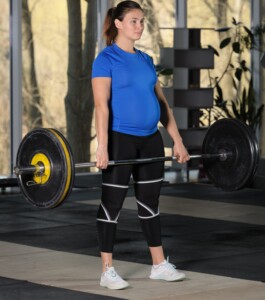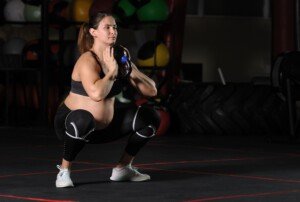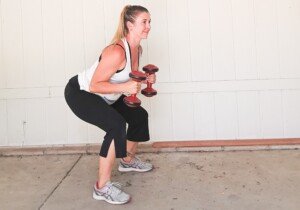![]()
The very exercises that are associated with power, muscle & competition are actually among the safest for a pregnant woman: squat, deadlift and lunge.
The back squat, deadlift and lunge (stationary or walking) are quite safe for the healthy pregnant woman.
However, some pregnant women who are strength training enthusiasts hesitate to do any of these compound moves.
Maybe this is because the back squat and deadlift are the very exercises that the strongest people in the world do for competition in powerlifting, strongman and CrossFit events.
But don’t let that trick you into thinking that the squat and deadlift, along with lunges, are not safe during your pregnancy.
It’s just that these three multi-joint movements are so versatile that they fit very nicely into any kind of strength training regimen.

Shutterstock/Paul Aiken
Another reason a pregnant woman might think the back squat, deadlift and lunges are not safe is because these exercises are done at very intense or mechanically heavy levels by serious fitness enthusiasts.
And though five sets of 5 RM deadlifts with only 90 seconds in between each set will leave a trainee feeling pummeled, remember … a deadlift routine can be adjusted to suit a woman who’s even nine months pregnant.
But there is one consideration you need to be aware of…
“In a normal healthy pregnancy, you likely can continue these exercises if you were doing them prior to your pregnancy,” says Danielle DonDiego, DO, a family physician and obesity specialist with SteadyMD, an online program where patients can call, text or video chat with their doctor anytime.
Dr. DonDiego is also a certified personal trainer and explains, “If these are a normal part of your routine, you can continue — as long as you haven’t been told otherwise by your personal physician.
“However, pregnancy is not a good time to start these types of exercises (or any other new and extreme training regimen). Continue what you were doing previously as long as your doctor says it’s okay.”
Why the Squat, Deadlift and Lunge Are Safe for Healthy Pregnant Women
The guidelines that are set forth by the American College of Obstetricians and Gynecologists encourage resistance training and do not prohibit the specific movements of the back squat (or any version), deadlift or lunge.

Shutterstock/Serghei Starus
But remember, it’s not wise to begin barbell squats and deadlifts for the first time while you’re expecting.
Already been doing these exercises?
The ACOG discourages anything that brings on symptoms or puts a pregnant woman at risk for falling or collisions.
By these guidelines, it would actually be much safer for a healthy pregnant woman to perform her usual sets of deadlifts or a squat variation than to participate in some kind of cardio activity – even light – in which she might stumble and fall — such as a hike or step class.

Shutterstock/Serghei Starus
Premature Labor
“There are only anecdotal reports that strenuous training may cause preterm labour,” states a report in the British Journal of Sports Medicine.
However, the training that’s referred to is aerobic, not strength.
“Nonetheless, until there is unequivocal evidence that strenuous exercise has no impact, a physically active woman with a history of, or who is at risk of, preterm labour should be advised to reduce her activity in the second and third trimesters,” continues the report.
If you’re at risk for preterm labor, definitely discuss strength training with your OBGYN, but again, the issue would involve intensity, not type of joint movement.
As long as there are no contraindications, a pregnant woman should embrace consistent, medium-intensity exercise for the same health benefits during pregnancy as prior to pregnancy.
When it comes to pregnancy and exercise, the big issues are intensity and risk of falls or collisions.
You can clearly see that three sets of 8-12 RM barbell squats are a lot safer than playing volleyball or participating in karate classes – the latter two which put a pregnant woman at risk for collisions or contact with other participants.
The paper in the British Journal of Sports Medicine points out that, just to play safe, it would be smart to avoid heavy resistance or any movements “that result in a large pressor effect during pregnancy.”
So just because you’ve been doing squats, deadlifts and heavy-weighted lunges long before you became expectant doesn’t mean that you should continue killing it during your pregnancy.
You can continue doing these exercises, but your heaviest squats and deadlifts are out, as these involve a large pressor effect.
A pressor effect refers to a rise in blood pressure. BP will rise during weightlifting, but the report refers to a “large” pressor effect.
You should discuss this with your doctor.
You should run your desired strength training program by your OBGYN.
Don’t just name specific exercises to your doctor, but ask about intensity and see what your doctor says.
Do not speak in terms of amount of weight lifted.
This is because, for example, a 135 pound deadlift, to your female physician who doesn’t strength train, might seem like an ultra-heavy lift – while it’s only your warmup!
Instead, speak in terms of protocols that make you strain and grit your teeth to get in the last few reps, that leave you heaving heavily at the end of the set.
Straining with heavy weights spikes blood pressure, but again, “heavy” is relative.
The 135 pound deadlift would spike the blood pressure of your non-trained doctor, but to a strong, experienced lifter it has less effect on her blood pressure because 135 is way below her working weight load.
Your OBGYN may not even know what a back squat and deadlift are.
Explain these and again, speak in terms of effort level (“I’m straining my guts out,” “I must grunt for the last few reps,” “When I’m done I’m only moderately out of breath,” etc.), rather than amount of weight lifted.
As for the walking lunge, the issue here may be balance for some women.
Pregnancy may throw off sense of balance. If you’ve never lunged before, there’s no reason to begin these during a pregnancy.

Shutterstock/Paul Aiken
A great alternative to lunges is the dumbbell squat — especially for those women who don’t feel comfortable with the barbell squat.
Dumbbells can be held at shoulder level, at the sides with straight arms or at chest level with bent arms.

Allie Edwards, a CPT specializing in prenatal and postpartum fitness, endorses the squat and other strength training exercises such as the kettlebell swing for expectant women.
Warning for Expectant Strength Trainers
Regardless of intensity level as well as type of weightlifting movement, the ACOG says to immediately cease activity if any of the following occur:
• Vaginal bleeding or leakage of amniotic fluid
• Difficulty catching breath – before the exercise starts
• Dizziness
• Headache
• Nausea
• Unexplained muscle weakness
• One calf with unexplained pain
• One calf that’s swollen, tender or unusually warm
The deadlift, squat and stationary lunge, from a mechanical standpoint, are very safe for pregnant women.
• Performed in one spot with both feet planted on the floor.
• Risk of losing balance is minimal.
• No impact to joints, no jarring motions.

 Dr. DonDiego
Dr. DonDiego Allie Edwards runs two blogs:
Allie Edwards runs two blogs: 






































